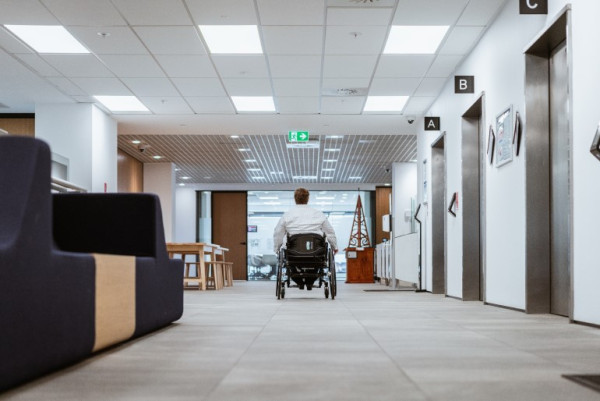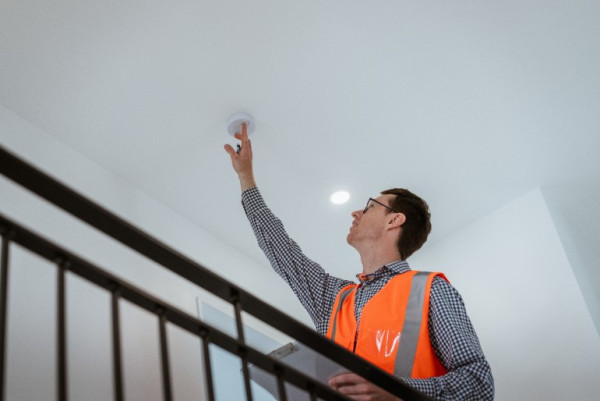2. Effectiveness of fire safety measures in the Building Code
MBIE has identified issues that could mean some buildings and building users may not be adequately protected from fire.
On this page
The Building Code regulations support the purposes and principles of the Building Act on fire safety. MBIE is aware some aspects of the regulations do not fully address risks.
2.1. People in some types of building can be at greater risk in a fire
The most frequent item raised by industry stakeholders during MBIE’s phase one review is that the Building Code does not adequately consider the evacuation needs of different occupants in a building, including those with disabilities.
The fire safety requirements in the Building Code use a general approach when they considering building users. Some people, such as the very young, old, those with respiratory issues, or those with other disabilities may be slower to respond to a fire or fire alarm or take longer to evacuate a building. At the same time, they may have to wait until the fire service responds to assist them. This means that for a longer time they risk being exposed to the fire, including its heat and smoke.
As well as the type of building users there can be a particular problem with the types of buildings, such as residential and accommodation buildings where people sleep, healthcare facilities, taller buildings, or buildings with a lot of people in them. In these cases, the consequences of a fire can be more severe than in other buildings.

Figure 2. One purpose of the Building Act is to ensure that people who use a building can escape from the building if it is on fire
2.2. Requirements are not always set at the right fire risk level for different types of buildings
MBIE has identified issues where the current requirements in the Building Code do not consider the specific hazards in a building. Separate types of buildings have their own hazards and require levels of protection.
The Building Code requirements were intended to apply to all building types. But some of its requirements do not apply to housing. Its remaining requirements apply equally to small residential and other buildings.
Because smaller residential buildings such as houses have their own unique challenges and fire problems, the Building Code’s broad requirements may not meet the right level for fire risks in housing. This could mean that complying with the Building Code is not always cost effective for residential building owners and may add unnecessary compliance costs for this group of owners.
In some cases, the Building Code requirements do not consider factors that can impact fire hazards, such as the building height, importance level, or its use. For example, taller buildings have specific considerations across multiple parts of the design, as do care and detention facilities.
Applying identical levels of performance to different buildings whose fire hazards are not the same creates a risk of unnecessary compliance costs for some building owners.
MBIE also identified other gaps in the types of fire hazards addressed by the Building Code. The Building Code does not include consideration of protection from wildfire or bushfire events in rural areas or at the edge of cities.
Case study: Rest home smoke control
Smoke leakage is a key consideration to determine whether part of a building could be a place of safety for building occupants during a fire. The Building Code definition for a ‘place of safety’ covers several fire safety requirements but does not address smoke leakage.
Fire and Emergency NZ (FENZ) are responsible for approving evacuation schemes under the Fire and Emergency New Zealand (Fire Safety, Evacuation Procedures, and Evacuation Schemes) Regulations.
FENZ provided feedback on an evacuation scheme that was submitted for approval for a rest home. It was noted that a lift serving multiple levels opened on to lounges designated as places of safety. As lift doors are very difficult to smoke seal, this represented a path for smoke travel into internal places of safety and could have resulted in greater risks for occupants.
The dispute was resolved by the building owner installing smoke curtains in front of the lift landing doors, at additional cost. In this example, the Building Code did not consider factors such as smoke leakage that can impact fire hazards.
The Building Code also does not address the hazards from electric transformers, overhead power lines, storage outside of buildings, and fires involving hazardous substances. These hazards can lead to fires starting or spreading to buildings.
These Building Code gaps in fire protection can result in greater effects from fire events and a lower overall level of safety in buildings.
2.3. The building code focusses on life safety and protection of other property
The fire safety objectives in the Building Code focus on life safety and protection of other property. They do not address protecting owners’ investments, or fire spread within a building under common ownership. Nor do they address protecting buildings which are of high value to the community.
Gaps in fire protection can increase the overall size of the fire and damage caused by the fire. Although the number of fire incidents has not significantly increased in the past 10 years, the number of fires that have spread beyond the building of origin has increased over 150% over the same period. This may also increase the challenges for firefighters responding to a fire.
The less protection provided for the building, the greater the risk there is to firefighters.
2.4. Emergency response needs to be considered in more detail
Fire and Emergency New Zealand (FENZ) has provided feedback that the provisions in the Building Code make it difficult for firefighters to respond to emergencies in buildings.
One of the principles of the Building Act is to account for the reasonable expectation a person is protected from injury or illness when carrying out rescue operations or firefighting. But stakeholders have raised concerns that the Building Code is:
- not in line with the responsibilities of firefighters set out in other legislation, and
- does not support firefighters following their standard operating procedures and training.
Specific concerns exist for:
- access into, and within, buildings
- the availability of fire extinguishers and water supplies, and
- the presence of firefighting facilities.
Dense urban environments make it challenging for firefighters to respond as roadways may be narrow or there may be not enough space to carry out the response to a fire.
Firefighters need the right amount of protection from flames and from building collapse, but these risks are not identified in the Building Code.
Access and evacuation are also not considered for other non-fire emergencies such as gas leaks, weather events, power outages, or medical emergencies.
These Building Code gaps can result in larger consequences of fires, which puts people and firefighters at unnecessary risks.
2.5. Maintaining fire safety over the life of the building can be a challenge
Building regulations ensure that fire safety is maintained over the life of a building through a combination of Building Code requirements and ongoing requirements in other regulations.
Buildings with certain safety and essential systems, known as specified systems, are required to have a compliance schedule, which sets out how to keep those systems in good working order.
A key finding from MBIE’s Operation Magazine was that there was often a mismatch between what was consented to be built, what a compliance schedule said was in the building, and what actually was in the building.
For some building components and systems, the Building Code and specified system regulations fail to provide assurance that buildings will perform as expected in the event of a fire.
For example, MBIE has identified specific issues to do with the design and maintenance provisions for external cladding and roofs, passive fire protection, means of escape features, and smoke control systems.
MBIE has also identified that there are mismatches between the description of fire safety systems in specified systems regulations. Gaps in protection in these areas mean the Building Code is:
- failing to adequately lower fire risks for some buildings, and
- makes it harder to comply with ongoing requirements throughout the life of the building.
MBIE has also identified that there are limited Building Code provisions for fire safety during the construction of a building. Fires during construction can spread to other buildings, and endanger the lives of construction workers and firefighters.

Figure 3. Specified systems such as emergency warning systems are subject to inspection, maintenance and reporting procedures under the Building Act
2.6. Questions on the effectiveness of fire safety measures in the Building Code
Please consider these questions if you are going to give MBIE feedback on this section.
- Do you agree with MBIE’s assessment of the issues on the effectiveness of fire safety measures in the Building Code?
- Are there any other issues MBIE should consider on the effectiveness of fire safety measures in the Building Code?
- Would you like to provide any other comments or feedback on the effectiveness of fire safety measures in the Building Code?

